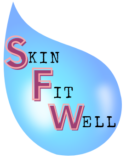Hormonal acne, characterized by acne occurring primarily in the jawline and chin area, can be difficult to clear.
Learn about what hormonal acne is, the symptoms of hormonal acne, what ashwagandha is, and how ashwagandha can help clear your skin.
Table of Contents
Hormonal Acne
As stated above, hormonal acne tends to occur around the jawline and chin area.
Hormonal acne can flare in times of stress, anxiety, or depression.
These ailments affect hormones in the body.
For example, stress affects cortisol levels in the body, which can lead to an increase in sebum production and clogged pores.
In females, hormonal acne can also flare around the menstruation period, or during ovulation.
Androgens
Androgen hormones like testosterone can increase sebum production in the skin (1).
Some people may have sebaceous glands that are more sensitive to hormonal fluctuations, leading to increased oil production.
Others may experience abnormalities with enzymes that play a role in the metabolism of hormones, leading to an increase in sebum production and acne (1).
Ashwagandha
Ashwagandha is a type of herb that can be primarily found in powder form.
It can be mixed with a multitude of substances to maximize its benefits for topical application, and well as oral consumption.
Although ashwagandha has been shown to increase testosterone levels in males, this has not been shown for females.
Instead, it has been shown to reduce levels of the hormone cortisol, have antioxidant activity, and is anti-inflammatory.
General Benefits
Scientific studies have shown that ashwagandha can improve memory, have stress reducing capabilities, improve the immune system, improve neurodegenerative diseases such as Alzheimer’s, and is anti-inflammatory (2).
Benefits For Skin
Ashwagandha provides many benefits for the skin.
Stress
For one, it helps to reduce stress levels.
In a study that included animals swimming, the group that received ashwagandha swam an average of 300 minutes longer than those that did not receive ashwagandha (2).
This means that it can reduce stress on the body, allowing you to have higher energy levels for longer periods of time.
One of the hormones that play a role in stress levels is cortisol.
Cortisol also promotes skin inflammation and acne. Ashwagandha interferes with cortisol levels.
Reduces Cortisol
The enzyme 11-hydroxylase has been shown to be reduced in those suffering from acne in old age (3).
Reduction in this enzyme leads to an increase in cortisol production, which in turn increases sebum production and ultimately causes acne.
The use of ashwagandha extract has been shown to increase this enzyme, and thus decrease sebum production. Patients see a decrease in acne (3).
Anti-inflammatory
Ashwagandha has anti-inflammatory properties.
It has been shown to reduce inflammation-inducing substances such as Interleukin-8 (IL-8) and tumor-necrosis factor (TNF-α) (4).
Use of ashwagandha extract also increases production of anti-inflammatory substances such as transforming growth factor.
The function of the skin is largely dependent on the skin cells or keratinocytes in the epidermis or outer layer of the skin.
By decreasing skin inflammation in the epidermis, ashwagandha directly reduces inflammatory acne and other inflammatory skin conditions like psoriasis (4).
Antioxidant Activity
Ashwagandha has been shown to promote antioxidant activity (5).
Reactive Oxygen Species (ROS) are a type of molecule that builds up in the body when exposed to UV rays and other DNA-damaging pollution.
They promote inflammation and play a role in the formation of acne (6).
Antioxidants destroy ROS.
Those suffering from acne have lower levels of antioxidants in their blood (6).
Oral consumption of antioxidants like ashwagandha work to increase antioxidant levels in the blood to reduce ROS.
It can help to prevent oxidative stress and inflammation in the body, leading to less acne.

References
- Bagatin E, Freitas THP, Rivitti-Machado MC, Machado MCR, Ribeiro BM, Nunes S, Rocha MADD. Adult female acne: a guide to clinical practice. An Bras Dermatol. 2019 Jan-Feb;94(1):62-75. doi: 10.1590/abd1806-4841.20198203. Erratum in: An Bras Dermatol. 2019 Mar-Apr;94(2):255. Machado MCR [corrected to Rivitti-Machado MC]. PMID: 30726466; PMCID: PMC6360964.
- Singh N, Bhalla M, de Jager P, Gilca M. An overview on ashwagandha: a Rasayana (rejuvenator) of Ayurveda. Afr J Tradit Complement Altern Med. 2011;8(5 Suppl):208-13. doi: 10.4314/ajtcam.v8i5S.9. Epub 2011 Jul 3. PMID: 22754076; PMCID: PMC3252722.
- Powell D, Inoue T, Bahtiyar G, Fenteany G, Sacerdote A. Treatment of Nonclassic 11-Hydroxylase Deficiency with Ashwagandha Root. Case Rep Endocrinol. 2017;2017:1869560. doi: 10.1155/2017/1869560. Epub 2017 Jun 20. PMID: 28713602; PMCID: PMC5496100.
- Sikandan, A., Shinomiya, T., Nagahara, Y.”Ashwagandha root extract exerts anti‑inflammatory effects in HaCaT cells by inhibiting the MAPK/NF‑κB pathways and by regulating cytokines”. International Journal of Molecular Medicine 42.1 (2018): 425-434.
- https://journals.lww.com/md-journal/fulltext/2019/09130/an_investigation_into_the_stress_relieving_and.67.aspx
- Kucharska A, Szmurło A, Sińska B. Significance of diet in treated and untreated acne vulgaris. Postepy Dermatol Alergol. 2016 Apr;33(2):81-6. doi: 10.5114/ada.2016.59146. Epub 2016 May 16. PMID: 27279815; PMCID: PMC4884775.

